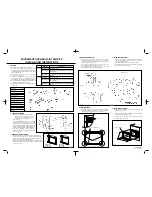
80
Data Files
©
2016-2017 SR Research Ltd.
the display is twice the display's width, and the screen resolution is set to 1024
by 768.
The high resolution of the EyeLink tracker data is preserved by multiplying the
position by a prescaler, recording the value as an integer in the EDF file, then
dividing by the prescaler when the file is read. The usual prescaler value is 10,
allowing gaze position to be recorded with 0.1 pixel of resolution. Actual
EyeLink tracker resolution is limited only by measurement noise.
4.4.2.4 Gaze Resolution Data
For gaze position, unlike the HREF data, the relationship between visual angle
and gaze position is not constant. The EyeLink eye tracker computes and can
record the instantaneous angular resolution at the current point of gaze. This is
measured as the units (usually pixels) per degree of visual angle, computed for
a change in x and y position separately.
This resolution data may be used to estimate distances between gaze positions,
and to compute velocities of eye movements. To compute the angular distance
of two points, compute the x and y angular distances of the points separately by
dividing the distance in pixels by the average of the resolutions at the two
points, then compute the Euclidean distance from the x and y distances. For
instantaneous velocity in degrees per second, compute the x and y velocities,
then divide each by the x or y resolution, square and add the x and y velocities,
and take the square root.
Resolution is computed at the point of gaze on the display, and can vary up to
15% over the display. The resolution data in an EDF file is recorded using a
prescaler for extra precision, and noted in the gaze-position section.
4.4.3 Pupil Size Data
Pupil size is also measured by the EyeLink eye tracker system. It may be
reported as pupil area, or pupil diameter. The pupil size data are not calibrated,
and the units of pupil measurement will vary with participant setup. Pupil size
is an integer number, in arbitrary units. Typical pupil area is 100 to 10000
units, with a precision of 1 unit, while pupil diameter is in the range of 400-
16000 units. Both measurements are noise-limited, with noise levels of 0.2% of
the diameter. This corresponds to a resolution of 0.01 mm for a 5 mm pupil.
Pupil size measurements are affected by up to 10% by pupil position, due to the
optical distortion of the cornea that accompanies rotations of the eye to view the
peripheral parts of the display, and camera-related factors. If you intend to
measure pupil size, the participant should not move their eyes during the trials.
They can be presented with a fixation point with aural stimulus presentation, or
a single stimulus position at display center may be used. It is also possible to
counterbalance stimulus position during the experiment. As well, since pupil
size is largely affected by luminance, cognitive load, and emotional responses,
















































